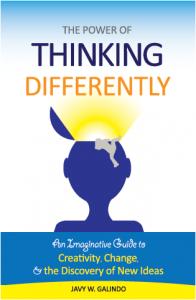Through my research, I have found that there are some commonalities amongst all the “creative thinking techniques” I have found in various Thinking-Outside-The-Box or Lateral Thinking books.
These commonalities include going with the flow (i.e. free-associating without judgement), mixing and matching (combining old ideas in new ways), re-framing (finding a new way to express a problem or finding a new context in which to view it), random stimulation (using random input to inspire your creative epiphanies), and establishing a creative environment.
For example, I was randomly inspired to create this new post by my psychology lecture today. In class, I spoke about how all of these techniques can be seen in action in many comedy improv games. This lead me to post many comedy improv videos on my course webpage that you can also find below:
Here is a comedy improv game called “Three-Headed Broadway Star”. Can you see how creative ideas are generated using the out-of-the-box techniques I listed above?
As you can see below, even “errors” are creative and lead to creative ideas. In fact, “errors” are often the easiest way of finding new insights and perceptions.
A large aspect of establishing an exploratory environment is creating an environment where everyone’s ideas are appreciated. Hence, one of the most important mantra’s in group creativity is “Accept. Agree. Add.” It’s important in all brainstorming sessions to encourage everyone’s input by building upon each others ideas, rather than refuting them. The key to idea generation in groups isn’t to find the “correct idea” but to find as many ideas as possible.
In class we discussed how criticism and judgement can halt creativity. In groups, instead of saying “Yes, and…” we often share ideas by saying “Yes, but…” which really means “You have a nice idea, but it is not as good as mine.” The problem with this is that it can discourage people from sharing ideas and can lead to conflict which halts the creative process. See the video below for an example:
Generating new ideas, whether by yourself or in a group, often requires that we give ourselves the freedom to consider all ideas that come to mind without fear of judgment and self-censorship. This is often hard to do since we become so conditioned to fear being “incorrect” or “wrong”.
However, in order to come up with a new way of looking at the world, we have to be willing to set this aside in order to consider all possibilities.




